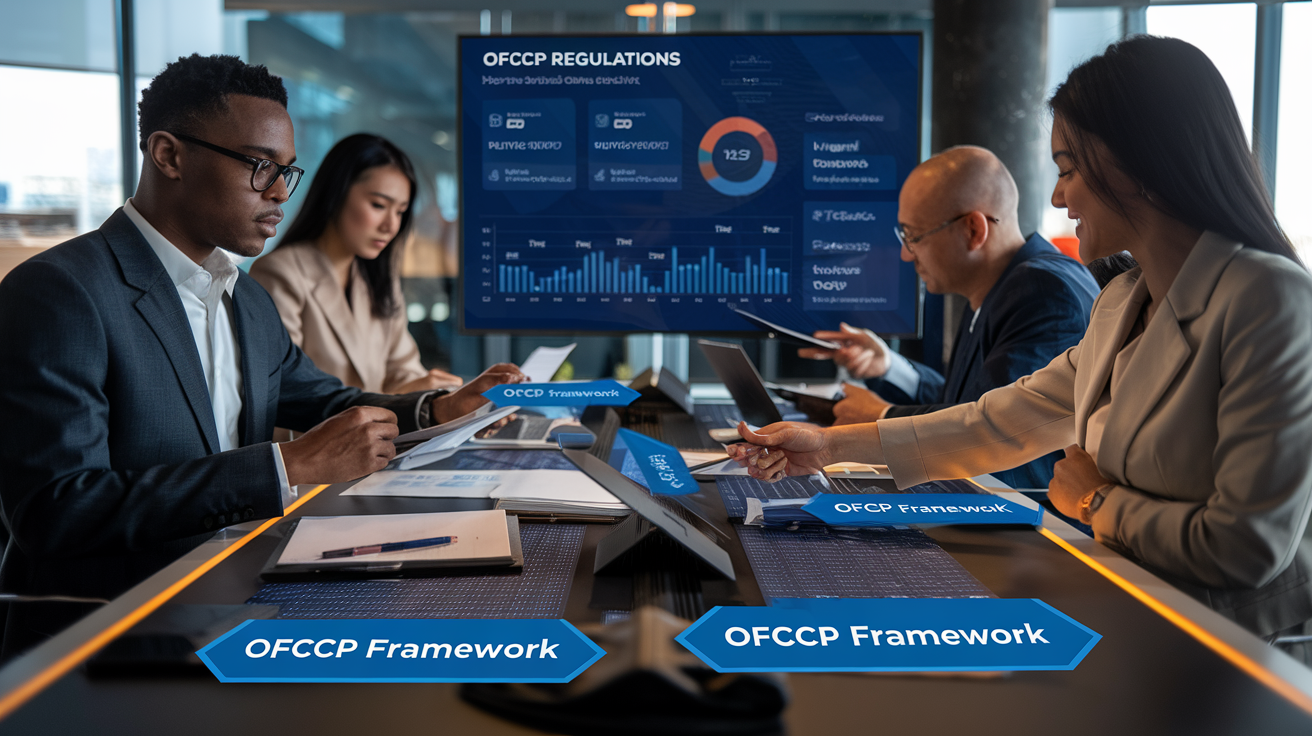The Compliance Conundrum: Navigating OFCCP Requirements with Automation

For federal contractors, compliance isn’t just a checkbox—it’s a constantly evolving maze of regulations that can make or break your business. With recent executive orders like the revocation of EO 11246 and shifting enforcement priorities at the Office of Federal Contract Compliance Programs (OFCCP), many organizations scramble to adjust their compliance frameworks while avoiding costly penalties and reputational damage. The stakes couldn’t be higher: contract termination, substantial fines, and diminished standing in your industry all loom for those who fail to navigate this landscape effectively.
What if you could transform this compliance burden into a strategic advantage? In today’s rapidly changing regulatory environment, automation tools are becoming essential for federal contractors seeking to maintain compliance while promoting diversity and inclusion in their workforces. Technology offers a path through the compliance conundrum, from streamlining applicant tracking to simplifying data collection and reporting. This post will guide you through understanding the OFCCP compliance framework, identifying its critical components, navigating the changing landscape, implementing practical strategies, and leveraging automation to turn compliance challenges into opportunities for organizational excellence.
Understanding OFCCP Compliance Framework

Key Laws and Regulations Enforced by OFCCP
The Office of Federal Contract Compliance Programs (OFCCP) operates as a vital division of the U.S. Department of Labor, responsible for enforcing several critical laws that govern federal contractors and subcontractors. These fundamental regulations include Executive Order 11246, Section 503 of the Rehabilitation Act of 1973, and the Vietnam Era Veterans’ Readjustment Assistance Act of 1974 (VEVRAA).
These laws collectively prohibit discrimination based on protected characteristics, including race, color, religion, sex, sexual orientation, gender identity, national origin, disability status, and protected veteran status. The OFCCP’s enforcement framework ensures that federal contractors maintain equitable employment practices.
Recent Changes Following Executive Order 14173
A significant shift in the compliance landscape occurred with President Donald Trump’s issuance of Executive Order 14173 on January 21, 2025. This executive order aims to “end illegal discrimination and restore merit-based opportunities” by revoking Executive Order 11246, which had been a cornerstone of OFCCP enforcement.
The transition includes a 90-day grace period for federal contractors to adapt to the previous regulatory framework effective January 20, 2025. It’s important to note that despite these changes, requirements under the Rehabilitation Act and VEVRAA remain unchanged and enforceable.
Additionally, the OFCCP has issued new guidance regarding using artificial intelligence (AI) and automated systems in employment decisions. This guidance emphasizes that contractors must ensure their AI tools comply with Equal Employment Opportunity (EEO) laws, regularly monitor for adverse impacts on protected groups, and maintain human oversight in decision-making processes.
Determining if Your Organization Qualifies as a Federal Contractor
Understanding whether your organization falls under OFCCP jurisdiction is crucial for compliance planning. Federal contractors contract with the federal government to provide goods or services. The compliance obligations apply to both prime contractors and subcontractors.
If your organization holds federal contracts, you must implement an Affirmative Action Program (AAP) within 120 days of contract commencement. This program must outline specific strategies to promote equal employment opportunities and should be regularly updated to reflect organizational changes.
Federal contractors must also maintain comprehensive records of employment practices for up to three years, use compliant job advertisements reflecting a commitment to non-discrimination, and provide reasonable accommodations for employees with disabilities unless doing so causes undue hardship.
With this understanding of the OFCCP compliance framework established, we’ll next explore the Critical Components of OFCCP Compliance that organizations must implement to maintain their federal contractor status and avoid potentially severe consequences for non-compliance.
Critical Components of OFCCP Compliance

Now that we’ve established a foundation in understanding the OFCCP compliance framework, let’s delve into the critical components that every federal contractor must address to maintain compliance.
Affirmative Action Requirements and Documentation
Federal contractors and subcontractors meeting specific monetary and employee thresholds must develop and maintain comprehensive Affirmative Action Programs (AAPs). These requirements involve documenting efforts to ensure equal employment opportunities regardless of race, color, religion, sex, sexual orientation, gender identity, national origin, disability, or veteran status. Starting April 1, 2024, contractors must certify their AAP compliance through the OFCCP’s online Contractor Portal, with a completion deadline of July 1, 2024. This certification process is crucial, as Directive 2018-07 indicates that AAP certification status will influence which contractors undergo compliance evaluations, with non-compliant contractors facing increased scrutiny.
Protected Groups: Women, Minorities, Veterans, and Individuals with Disabilities
The OFCCP framework focuses explicitly on protecting historically marginalized groups. Until the recent change in Executive Order 11246, contractors with over 50 employees and contracts exceeding $50,000 were required to create written plans promoting diversity and inclusion. Despite the rescission of EO 11246, Section 503 and VEVRAA affirmative action plans for veterans and individuals with disabilities remain in effect. Contractors must continue demonstrating their commitment to preventing discrimination based on protected characteristics while adapting to the evolving compliance landscape.
Equal Employment Opportunity Obligations
Beyond affirmative action, federal contractors must adhere to equal employment opportunity obligations. These include maintaining compliance with longstanding civil rights laws such as Title VII of the Civil Rights Act. The distinction between anti-discrimination and affirmative action is crucial to understand: while anti-discrimination laws prohibit unfair treatment, affirmative action requires proactive measures to ensure equal opportunities. As the regulatory landscape evolves, contractors must conduct thorough audits of their employment policies and train HR personnel to implement these requirements effectively.
With OFCCP requirements evolving, contractors face the challenge of navigating a changing compliance landscape, which we’ll explore in the next section.
Navigating the Changing Compliance Landscape

Now that we’ve examined the critical components of OFCCP compliance, it’s essential to understand how recent changes have transformed the regulatory landscape for federal contractors.
A. Implications of Executive Order 11246 revocation
The compliance landscape changed dramatically when President Trump signed Executive Order 14173, which revoked Executive Order 11246. This revocation eliminated the previous requirements that prohibited employment discrimination and mandated affirmative action programs for women and minorities. Following this change, the OFCCP announced a significant restructuring, reducing its operations from 55 offices to just four and cutting its workforce by 90% (from 479 employees to only 50). This restructuring was accompanied by a cease and desist order that halted investigations and enforcement activities under EO 11246, as outlined in Secretary’s Order 03-2025.
B. Maintaining compliance with Section 503 and VEVRAA
Despite the revocation of EO 11246, federal contractors must still adhere to statutory obligations under Section 503 of the Rehabilitation Act and the Vietnam Era Veterans’ Readjustment Assistance Act (VEVRAA). These laws continue to require affirmative action programs for individuals with disabilities and veterans. However, the future enforcement of these remaining obligations remains uncertain as the OFCCP updates its policies to align with the new executive order. Contractors should note that for 90 days from April 21, 2025, they may continue complying with regulations that were in effect on January 20, 2025.
C. State-level affirmative action requirements
While federal requirements have changed, it’s worth noting that state-level affirmative action requirements may still apply to contractors. The federal court ruling in Nat’l Ass’n of Diversity Officers in Higher Education v. Trump issued an injunction affecting certain aspects of EO 14173. However, it did not challenge the revocation of EO 11246. This creates a complex compliance environment where contractors must navigate changing federal standards and potentially different state-level requirements.
With this changing landscape in mind, next we’ll explore practical compliance strategies that federal contractors can implement to ensure they meet their remaining obligations while adapting to these significant regulatory shifts.
Practical Compliance Strategies for Federal Contractors

Now that we’ve explored the evolving OFCCP compliance landscape, let’s examine practical strategies federal contractors can implement to ensure ongoing compliance.
A. Essential record-keeping and documentation practices
Maintaining comprehensive documentation is crucial for OFCCP compliance. Federal contractors should organize and preserve all records related to Affirmative Action Plans (AAPs), applicant data, and hiring decisions. Poor documentation can significantly hinder your ability to defend against potential compliance issues during audits. Establish systematic procedures for collecting and storing applicant demographic information, job posting details, and personnel activities, including hiring, promotion, and termination data. This proactive approach to record-keeping ensures you’ll have readily accessible information when facing an OFCCP audit.
B. Preparing for OFCCP audits and evaluations
When preparing for OFCCP audits, understand that the process typically begins with a desk audit notification, requiring submission of documentation within 30 days. This includes your AAPs, compensation data, and other required records. Training staff involved in hiring and promotion on AAP implementation and documentation protocols is essential for audit readiness.
Consider conducting a “reverse audit” with an external team to identify compliance gaps before actual OFCCP evaluations. This practice run helps prepare your staff for questions and procedures they’ll encounter during an official audit. Develop a clear response strategy and maintain open communication with compliance officers to facilitate a smoother evaluation process.
Remember that audit outcomes may include a Notice of Compliance (NOC), Notice of Violation (NOV), Predetermination Notice (PDN), or potentially a Conciliation Agreement (CA) for resolving issues without litigation. Severe cases may escalate to Consent Decrees involving court oversight.
C. Updating organizational policies and job postings
Federal contractors must regularly review and update organizational policies to align with current OFCCP requirements. Ensure your job postings are distributed through appropriate channels, including relevant state job banks, to reach diverse candidates such as minorities, veterans, women, and individuals with disabilities.
Continuously collect and maintain data regarding job postings and applicant demographics to demonstrate compliance with equal employment opportunity guidelines. Regular policy reviews should incorporate the latest requirements under the Vietnam Era Veterans’ Readjustment Assistance Act (VEVRAA) and Section 503 of the Rehabilitation Act, as these statutory mandates remain enforceable despite recent executive order changes.
With these practical compliance strategies in place, federal contractors can explore how leveraging automation technologies can further enhance their OFCCP compliance efforts while reducing administrative burden.
Leveraging Automation for OFCCP Compliance

Now that we’ve explored practical compliance strategies for federal contractors, let’s examine how technology can revolutionize your OFCCP compliance efforts.
Benefits of Applicant Tracking Systems for Compliance Management
Implementing an intuitive applicant tracking system (ATS) transforms OFCCP compliance management. Solutions like Mitratech Circa provide a centralized platform to oversee candidates from diverse recruitment channels. This integrated approach allows organizations to document and retain proof of job postings, critical evidence during OFCCP audits. By automating compliance processes, federal contractors can focus more on building diverse and inclusive workforces than on administrative paperwork.
The proper ATS also enables organizations to conduct comprehensive compliance audits, establish clear diversity goals, and measure success through key metrics such as representation and retention rates. These systems provide real-time visibility into compliance status, allowing contractors to make adjustments proactively rather than reactively.
Streamlining Data Collection and Reporting Requirements
OFCCP compliance software streamlines the mandatory data collection and reporting processes that federal contractors face. Mitratech’s solutions simplify posting job openings to state job boards and Electronic Service Delivery Sites (ESDS) across all 56 states while providing on-demand reporting capabilities. This automation enables organizations to prepare confidently for OFCCP audits with readily available documentation.
Advanced features allow federal contractors to continuously analyze their compliance efforts and make necessary adjustments based on gathered insights. The automated tracking and reporting tools eliminate manual processes, reducing human error and ensuring more accurate compliance data.
Supporting Diversity Hiring Initiatives Through Technology
Technology is pivotal in advancing diversity initiatives that align with OFCCP requirements. Automation tools facilitate outreach to over 15,000 community-based organizations, supporting affirmative action goals and helping contractors access diverse talent pools. These solutions also assist in identifying target demographics related to gender, race, ethnicity, disability, and veteran status.
Compliance software helps organizations adhere to specific regulations like the Vietnam Era Veterans’ Readjustment Assistance Act (VEVRAA) by managing mandatory job listing requirements, establishing annual veteran hiring benchmarks, and prioritizing open positions for veterans. Additionally, these tools can enhance employer branding by highlighting commitment to diversity through various marketing strategies, including diversity badges and participation in career events.

Navigating OFCCP compliance doesn’t have to be overwhelming. As federal contractors face an evolving regulatory landscape, understanding the fundamental framework—from Executive Order 11246 to Section 503 and VEVRAA—creates the foundation for successful compliance. The recent changes, including Executive Order 14173, highlight the importance of staying adaptable and informed about compliance requirements.
Automation offers a powerful solution to the compliance conundrum. Tools like Circa’s applicant tracking software streamline data collection, support diversity initiatives, and ensure accurate documentation for potential audits. By embracing technology-driven compliance strategies, federal contractors can mitigate legal risks and enhance their reputation as socially responsible employers committed to equal opportunity. Remember that compliance isn’t just about avoiding penalties—it’s about creating a workplace where fairness and inclusion are prioritized, benefiting your organization and society.
Get consistent, reliable exposure for your job listings using Job Multi Poster. Whether you’re distributing through JobScience, Lever, or JobDiva, we make ATS-powered posting effortless. Learn more about our services: Network Traffic Insights | Diversity and Inclusion Job Posting.
Let dstribute.io help your team post once, track everywhere, and reach the talent that matters. Book a consultation or sign up now to start distributing smarter today.